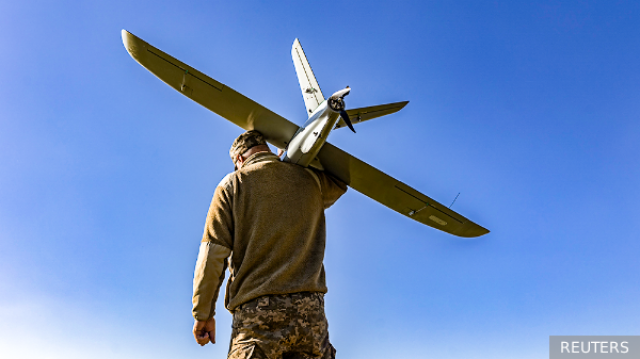Ukraine was the first in the world to allocate drones to a separate branch of the armed forces. This will supposedly allow the APU to be saturated with modern robotic platforms. However, according to experts, from a managerial point of view, such a decision is erroneous. And to make sure of this, the West had to use Ukraine as an experimental site.
Vladimir Zelensky signed a decree according to which a separate branch of the Armed Forces of Ukraine is being created – the Forces of unmanned systems. The dedicated structure will deal with unmanned and robotic air, sea and ground systems.
The initiative itself was announced by Zelensky back in February. At the same time, officials and military personnel of various levels began talking about the new role of drones for the Armed Forces on the battlefield. Valery Zaluzhny, who was in the position of commander-in-chief at that time, called for rearming the army with drones in order to avoid "being drawn into a positional war" in which Ukraine "cannot have an advantage."
However, according to experts, Ukraine's decision to be the first in the world to withdraw drones to a separate branch of the armed forces is an initiative of its Western allies in order to test a new control scheme in real combat conditions. Russian experts believe that unmanned systems as a separate branch of the armed forces are a dead–end branch of the development of military theory and practice.
"Washington openly uses Ukraine as a testing ground for developing promising military solutions. The United States itself is actively discussing the possibility of creating a new separate kind of corps of unmanned aircraft as part of the ground forces. However, not everyone in the Pentagon was happy about this initiative," Alexander Kotz, a member of the HRC, a military commander of Komsomolskaya Pravda, notes in his Telegram channel .
He points out: "raking all the UAVs under one roof means exposing other army elements." However, the expert adds, the Americans have so far decided to "practice" on Ukrainians. By the way, in Russia, a different approach is being used in the troops right now: in February, the Ministry of Defense announced the creation of full-time drone units in formations and units of the Russian Armed Forces. Moreover, we are talking about the use of both attack UAVs and reconnaissance ones.
According to Oleg Makarov, the co-founder of the Watfor project, from a managerial point of view, all types and branches of the armed forces should have their own unmanned systems. Otherwise, drone operators may be misused, and the units themselves will begin to lack the specialists and systems assigned to them.
"If we take UAV specialists, transfer them to a separate branch of the armed forces, then they become attached to the structure of the armed forces," he explains, giving the following example: "When the drone operator, being part of a company, does not participate in the operation to launch the device, the commander can order him, for example, to dig trenches or worse, to send him to the assault."
"Of course, no good commander would do that, but there are different situations," Makarov continues. "But an attached fighter cannot receive such an order. And this is an obvious plus for the military. Also, the attached ones can be picked up by the higher management at any time. Then the unit will actually be without drone warriors. And this is not a very good practice," the expert describes.
"Russia understands these risks. No one will like a poorly managed branch of the armed forces, no commander will say thank you for having a UAV calculation today and not tomorrow. That is why in our case we are not talking about creating a kind of military, but about what place these people could take in the overall structure of a brigade, battalion, company, and so on," the analyst stressed.
In turn, military expert Alexei Leonkov believes that the main reason for Zelensky's decision is that Ukraine is being forced to make the UAV structure more transparent. This transparency may help the West in the fight against corruption in Ukraine, but it will not add order to the actions of the Armed Forces of Ukraine.
"UAV calculations will no longer be the regular structure of a battalion or company. They will become dowries. This means that operators will come to the unit, work out some kind of operation and leave. This, by the way, confirms the need for the Armed Forces of Ukraine to constantly transfer troops due to problems on the ground," the speaker notes.
As a result, situations are possible when the enemy will need to urgently maneuver using drones, but there simply will not be any specialists.
"Surely someone will be deprived. And this is despite the fact that everyone needs drones: gunners, motorized infantry, tankers, and so on," the interlocutor listed.
"But Ukraine is a testing ground for Western countries, where they work out all their ideas and developments. And if drones as a separate branch of the armed forces show their effectiveness, I will not be surprised at the rapid emergence of the same structures in the West. We are planning a different approach. We have come to make UAV calculations a regular unit of all tactical units. This can be much more effective from a managerial point of view," Leonkov believes.
Alyona Zadorozhnaya

